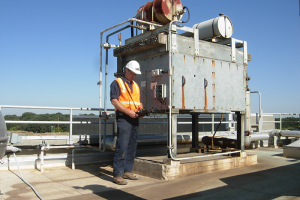One small regulatory update can lay out the path toward decarbonization
Within health care circles, the impact of Hurricane Fiona on Puerto Rico’s power grid has once again begged the question of how best to distribute diesel fuel among health care providers for emergency power. But one issue that has been left undiscussed poses a far more significant question: Why does the health care sector still use diesel fuel?
At this point, national health care policy officials are well aware of three realities.
First, health care providers increasingly use diesel for emergency power as the number, intensity and duration of disaster events continue to increase. This is because the Centers for Medicare & Medicaid Services’ (CMS’) 2016 fire safety and emergency preparedness regulatory rules require providers, particularly hospitals, to meet the 2012 edition of NFPA 101, Life Safety Code® and related standards including the 2012 edition of NFPA 99, Health Care Facilities Code. Specifically, health care providers’ emergency power supply (EPS) must be generator driven by spark-ignited diesel or gas turbine engines.
Second, health care consumes a vast amount of diesel and other fossil fuels. Per the Environmental Protection Agency’s (EPA’s) greenhouse gas (GHG) calculator, that figure is equivalent to burning 500 billion pounds of coal or 1.16 billion barrels of oil annually.
Finally, the Department of Health and Human Services (HHS), which oversees CMS, continues to do nothing measurable to reduce health care’s GHG pollution. Continuing to ignore the problem means the sector’s annual 500 million metric tons, or 8.5% of total U.S. emissions, will moreover continue to worsen minority populations’ disease burden. Ironically, these populations are disproportionately served by federally qualified health centers (FQHCs) that are regulated by HHS’s Health Services and Resources Administration (HRSA).
These realities explain why after Hurricane Maria in 2017 an increasing number of Puerto Rico’s community health clinics (CHCs) began converting to solar power microgrids with battery storage. To date, approximately 16 have done so.
Beyond Puerto Rico, CHCs and hospitals in California, Massachusetts, Florida, New Jersey, New York and Texas have also successfully piloted self-contained solar and battery microgrids for their emergency power and essential power. Beyond improvements in care quality — absent having to close in disaster scenarios — and boosted climate resiliency, solar power appreciably improves these providers’ financial sustainability. One California CHC, having converted to nearly 100% solar, reduced its annual power bill by 90% and now receives considerable energy rebate income from Pacific Gas & Electric.
Even if, magically, regulators in Puerto Rico and elsewhere could equitably apportion diesel when demand exceeds supply, the fuel’s use is still subject to supply disruptions. Diesel fuel is also finite, degrades over time and requires storage. Diesel generators have also proven to be unreliable. For example, during Hurricane Sandy, six hospitals in New York were forced to completely shut down and remained closed for more than 100 days. And again, the emissions from diesel fuel combustion causes incalculable health harms.
Alternatively, solar power, when paired with modern storage technology, is more reliable and neither emits GHG pollution nor contributes to human-induced climate change. Concerning cost or financial sustainability, per studies by, among others, the Department of Energy, the International Renewable Energy Agency (IRENA), the National Renewable Energy Laboratory and the World Resources Institute, solar and other renewable energy sources are comparatively cheaper than fossil fuels per megawatt hour, have lower operating costs and can be developed more rapidly, plus solar panels offset their manufacturing energy within approximately two years of operation. As for battery storage, lithium-ion system prices declined as much as 85% between 2010 and 2018. Today, it is cheaper to the save the climate than to continue to destroy it.
Autonomous microgrids offer the possibility of fail-safe islanding a provider’s life safety emergency power. More fully appreciated, microgrids can make essential and emergency power a distinction without a difference.
This possibility has not been unappreciated by NFPA standards committees. In 2021, the NFPA 99 technical committee identified “health care microgrid” as an acceptable emergency power supply source.
The importance of an updated NFPA standard was immediately recognized by state health planners, particularly in California. Between 2018 and 2019 the state experienced 50,000 blackouts affecting 51 million residents. In a September 2021 report for the California Office of Statewide Health Planning and Development, the authors addressed the problem of installing solar microgrids as “an EPS in a code compliant manner.” Specifically, they questioned whether CMS, requiring providers to meet now-outdated NFPA standards, would refuse to reimburse solar microgrid-powered providers. Therefore, the report’s authors recommended CMS create a task force to publish subregulatory guidance that updates the agency’s 2016 regulatory rules allowing microgrids to be utilized for emergency power.
CMS has an opportunity to improve providers’ emergency power supply reliability (and potentially, their essential power supply as well) along with provider sustainability and care quality while reducing health care inequities. For FQHCs, EPS regulatory reform also provides additional impetus to monetize recently legislated Inflation Reduction Act tax credits that for the first time are available to tax-exempt entities. Federal regulators need to recognize the renewable energy microgrid future is here. One small, practical regulatory update can finally put the health care sector on a path towards decarbonization.




